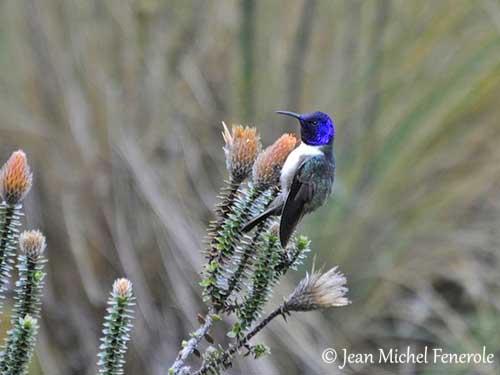
Fr: Colibri du Chimborazo
All : Ecuador-Andenkolibri
Esp : Colibrí del Chimborazo
Ital : Stella del Monte Chimborazo
Nd: Ecuadoraanse Bergnimf
Sd: Ecuadorbergsstjärna
Photographers:
Roger Ahlman
Pbase Galleries Peru and Ecuador
Didier Buysse
Vision d’Oiseaux
Jean Michel Fenerole
Photos d’Oiseaux du monde
Text by Nicole Bouglouan
Sources:
HANDBOOK OF THE BIRDS OF THE WORLD Vol 5 by Josep del Hoyo-Andrew Elliott-Jordi Sargatal - Lynx Edicions - ISBN: 8487334253
Understanding the evolutionary history of a high Andean endemic: the Ecuadorian hillstar (Oreotrochilus chimborazo) By Carlos Antonio Rodríguez Saltos & Elisa Bonaccorso
BirdLife International (BirdLife International)
Wikipedia, la enciclopedia libre
Ecuadorian Hillstar
Oreotrochilus chimborazo
Apodiforme Order – Trochilidae family
BIOMETRICS:
Length: 13 cm
Weight: 7,8 - 8 g
DESCRIPTION:
The Ecuadorian Hillstar is a species of high-altitude habitats. It is found in vegetated areas up to the snow-line in the Andes of Ecuador and S Colombia where it lives in cool temperatures.
The adult male has dark olive-green upperparts. The outer flight feathers are blackish. The tail is slightly forked and shows dark central rectrices, whereas other tail feathers are white with blackish edges and tips. The outermost rectrices are largely dark with narrower outer web.
The underparts are white. Undertail-coverts are dark. There is a blackish line down centre of belly, joining the dark vent and the undertail-coverts. Undertail is similar to uppertail.
Head and upperthroat show glittering purplish-blue hood. The nominate race has glittering green lower throat, bordered by narrow black upperbreast band.
The slightly curved bill is black. The eyes are dark brown. Legs and large feet are black.

Feeding typically on nectar
from Chuquiragua insignis
The female has pale bronze-green upperparts. The tail is dark shining green, usually less forked than in male. The outer pair of rectrices shows white base and tip. The flight feathers are dark.
On the underparts, the throat is white and heavily speckled with brown rounded spots. Rest of underparts is pale greyish.
In both sexes, we can see a small white postocular spot.
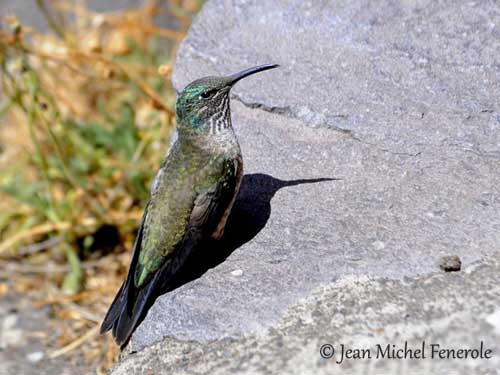
The juvenile male shows pale area across the upperbreast, and the immature male has dark bluish-green hood.
We can find three subspecies:
O.c. jamesoni (here displayed) is found in mountains of extreme S Colombia and N Ecuador. This race has entirely violet hood, and the outer tail feathers show less white than in nominate.
O.c. soederstroemi is found in C Ecuador (Mt Quilotoa). This one has only some green feathers at lower edge of throat patch.
O.c. chimborazo occurs in C Ecuador (Mt Chimborazo and probably Azuay Province).
VOICE: SOUNDS BY XENO-CANTO
The Ecuadorian Hillstar utters series of aggressive, fast chattering during fights between males defending their feeding territory. We can also hear high-pitched, monosyllabic chirps and whistles, given when the birds are feeding at rich food source.
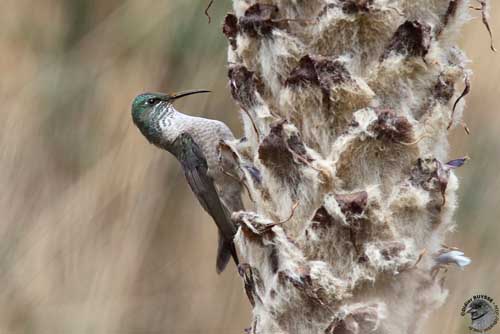
HABITAT:
The Ecuadorian Hillstar is found at high elevation, between 3500-5200 metres in the Andes. It frequents vegetated areas along several isolated volcanic mountains. It is often seen in arid puna-like grassland habitats with scattered trees and shrubs, near the upper border of páramo zone. It also frequents more humid areas and rocky slopes.
At night, it roosts in caves or crevices. It sleeps in torpid state due to the low temperatures. In harsh weather conditions which are frequent at high elevation, it uses caves for shelter.
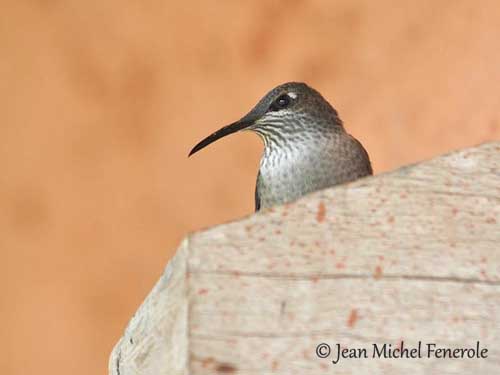
RANGE:
See above in “subspecies”
BEHAVIOUR:
The Ecuadorian Hillstar feeds mainly on nectar from flowers, and especially those of Chuquinagua insignis, a shrub with orange flowers. But nectar can be taken from other plant species such as Malvaceae and Puya, an endemic Andean plant.
Nectar is complemented by numerous insects and spiders caught by hawking and by gleaning from vegetation, leaves and rocky surfaces.
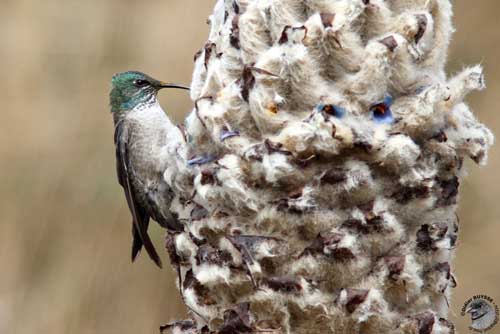
This species is fairly aggressive and territorial. The male performs aerial and threat displays when defending its area. It also perches high on exposed branches close to its territory. Intruders that ignore its visual and vocal displays are strongly attacked in flight, involving sometimes direct physical fights. These encounters can be really aggressive but rarely harmful to the birds.
Courtship displays to attract females are similar to defence displays.
In this genus Oreotrochilus, only the females hold territories. Males visit them during the breeding season. From some reports, the female might feed the male prior to copulation.
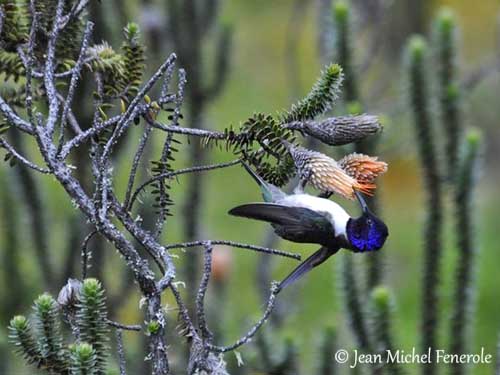
The Ecuadorian Hillstar may perform some altitudinal movements after the breeding season, due to harsh weather conditions in high-altitude areas.
FLIGHT:
The Ecuadorian Hillstar does not hover when feeding on nectar, but it perches on the flowers. Aerial displays are performed both in defence and courtship behaviour. By strong wind, it flies low from the ground.
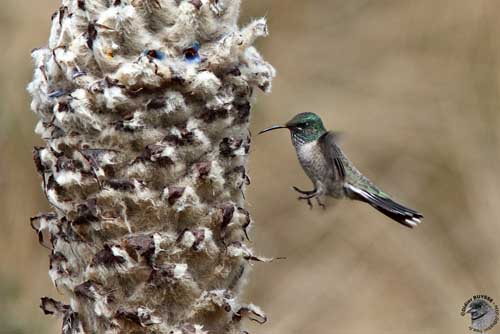
Feeding typically on nectar
from Chuquiragua insignis
REPRODUCTION:
Breeding season occurs mainly between October and February, but nests can be found throughout the year.
Unlike the usual hummingbirds’ nests, that of the Ecuadorian Hillstar is fairly large in order to protect the brood against harsh weathers and cold at night.
The nest is usually situated in cave, gully or crevice in steep ravine, often below an overhang for better protection. It is made with moss, roots, dry grass, feathers, rabbit fur and vegetal down. Several nests may be found sometimes in close vicinity, due to scarce sheltered sites. A nest may also be suspended from small ferns or built in trees such as Polypelis, between 60 cm and 6 metres above the ground.
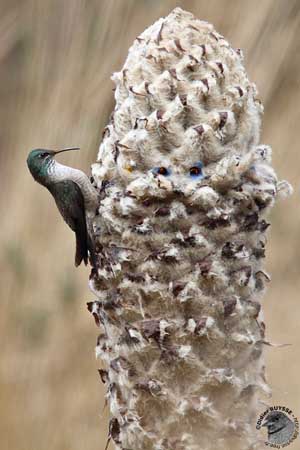
The female lays 2 eggs and incubates alone during 14-19 days. Both adults feed the chicks during 3-4 weeks. An adult may perform about 140 movements per day to feed the young. At hatching, the chicks are black and naked. The young birds often use the nest for some time after fledging.
DIET:
The Ecuadorian Hillstar feeds primarily on nectar from flowers, but it also takes numerous insects and spiders.
PROTECTION / THREATS / STATUS:
The Ecuadorian Hillstar is fairly common in its habitat. The high-altitude range is not subject to high level of disturbance and degradation. The species occurs too in several protected areas, and it is not currently threatened.
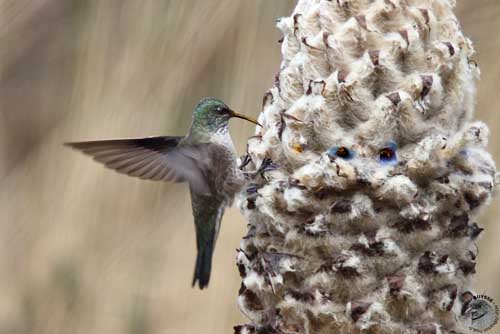
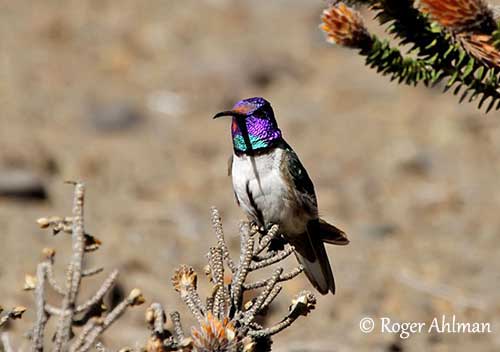
Nominate race
O.c. chimborazo
With pollen at bill base